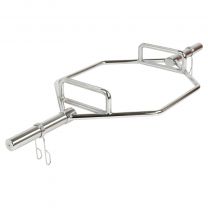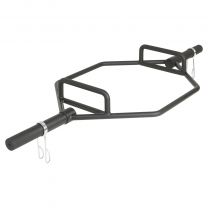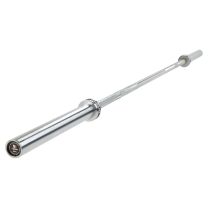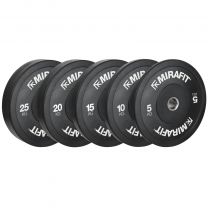Trap Bar Deadlift Vs Barbell Deadlift: Which One Is Best?
Trap Bar Deadlift Vs Barbell Deadlift: Which One Is Best?

The deadlift is one of the main lifts you should be doing at the gym. They’re essential for building mass as well as strengthening your hamstrings and lower back.
The thing is, as important as they are, when it comes to getting the most out of your training, it really is all about the execution.
And varying your training by using different equipment to perform the same types of lift, will really impact your results.
So, the question is: are trap bar deadlifts better than barbell deadlifts?
Below, we go through the pros and cons of each type of deadlift, to give you the answer.
What is the difference between a trap bar deadlift and a regular deadlift?
Before we get into the ins and outs of each type of deadlift, let’s just quickly recap what they are.
• A trap bar deadlift is a deadlift performed with a hex weight bar along with a set of bumper plates. The lifter starts off inside the hex and bends down to grip the handles at either side. They then lift the weight straight up to deadlift.
• A barbell deadlift is the traditional style deadlift. It is typically performed with a 7ft Olympic Barbell or a Women's Olympic Barbell and a set of bumper plates. The weight bar starts on the ground in front of the lifter. They then bend to pull the weight up and back slightly to deadlift.
Essentially, these are both deadlifts. However, there are some key differences which will affect the results you see from doing each one.
Muscles worked
Although both types of deadlift work your posterior chain, the difference in positioning means that each lift emphasises different muscle sets.
With the trap bar or shrug barbell deadlift, the weight is pretty much central throughout the whole lift. This means there’s less focus on your lower back and more emphasis on your quads. In some respects, the trap bar deadlift is quite similar to a squat style movement. And because the movement is fairly linear, you can afford to inject more power into your lifts.
With a barbell deadlift, the bar is positioned in front of you. This means you need to counterbalance the weight as you lift. So, instead of lifting the weight straight up, you’re lifting it up and back slightly.
Doing this engages your lower back much more than the hex bar deadlift. So, barbell deadlifts will target your posterior chain more. However, there is also more stress on your lower back – which can be a good thing but is something to be conscious of, depending on your current fitness levels.
Grip

There are different ways you can grip the barbell when performing deadlifts. The main grips consist of:
• Double overhand grip
• Mixed grip
• Double overhand hook grip
The double overhand grip is great for beginners and the most common type of grip for doing deadlifts. It’s fairly comfortable to maintain and is one of the most balanced. This type of grip, however, is not always suitable for lifting heavier loads. This is mostly because you need a lot of grip strength to be able to hold onto the bar as you progress while using a double overhand grip.
Next, is the mixed grip. This grip is commonly used among more experienced lifters as well as powerlifters. It’s a more secure grip and is therefore suitable for much heavier loads. The drawbacks of this type of lift is that it can cause a slight rotation in the body. This, in turn, can lead to imbalances and a possible risk of injury. As a result, some lifters alternate which hand they supinate to help keep everything even.
Finally, the double overhand hook grip is very similar to the double overhand grip except the thumb sits under your fingers slightly. This can be very painful to maintain and something which even advanced lifters will need to get used to. Mainly because you’ve got all of the weight that you're lifting, resting on a such a small part of your hand.
The double overhand grip is a secure and balanced grip. It just takes a lot of training.
When it comes to gripping a trap bar, there isn’t much room for variation. It’s just about getting an even, central grip that allows you to pick up the bar without it tipping forward or back.
In general, the trap bar grip is a lot easier to achieve. And you’ll have the positioning down within a couple of sessions.
Barbell grips are more technical and there’s a lot more variation involved. However, this does mean there’s more scope for progression. And you can also adjust your grip depending on your height and arm length. Shorter people can sometimes struggle with holding a trap bar as they have to have their arms out quite wide.
Weight path

When performing a trap bar deadlift, the weight path is pretty straight. This makes it slightly easier to do in comparison to a barbell deadlift. It also means you can inject more power into your lifts and potentially lift more weight than you would with a barbell.
When using a barbell to deadlift, the weight starts off in front of you. This means it’s a more technical lift where you need to counterbalance the weight to stop you from either tipping too far forwards or extending too far back.
These adjustments, however, allow for a greater amount of muscle engagement and stabilisation.
Mobility
Trap bar deadlifts don’t require as much hip mobility as traditional barbell deadlifts.
The handles are slightly higher on a trap bar and they’re also easier to reach as you don’t need to bend forwards as much.
Like squats, barbell deadlifts require a good amount of hip mobility. And this isn’t something that comes easily to a lot of people. In fact, more often than not, many lifters end up curving their back slightly to reach the bar, which can put them at risk of injury.
Accessory lifts
When it comes to building strength, supplementing your training with accessory lifts is key. This means, varying your deadlift style and doing exercises such as sumo deadlifts and deficit deadlifts.
This is easier to do if you’re training with a barbell as there’s a lot more scope for variation while still using the same bar.
It’s still possible to supplement trap bar deadlifts. You will just need to consider using a range of equipment to make sure you’re still hitting the correct muscle groups.
Competition lifts

If you’re looking to compete in something like a powerlifting competition, you’ll need to be able to do competition style lifts.
The three main lifts in a powerlifting competition are squat, bench press and deadlift. All three of these lifts use a barbell. So, you will need to train with one to be able to compete.
Trap bar deadlifts vs barbell deadlifts: which is better?
There isn’t - and never has been – one single way to build strength. Different approaches work for different people. And not only that, doing the same thing over and over isn’t going to help you progress. Each type of deadlift has its own benefits and will help you progress in different ways.
So, the answer is – do both.
By varying your deadlift style as well as the equipment you’re using, you will be giving yourself the best possible chance to adapt, grow and get stronger.
That being said, both the trap bar deadlift and the barbell deadlift each have their own benefits.
Trap bar deadlift benefits

• They’re great for power - most people can lift more when doing trap bar deadlifts so they’re great for maximal lifts.
• They’re ideal for beginners - trap bar deadlifts are easier to perform. The bar path is straight, the grip is easier to achieve and there’s less stress on your lower back.
• You don’t hit your shins - it’s easy to hit your shins with the bar when doing barbell deadlifts. So by using a trap bar, you can eliminate this risk.
• They’re easier on your joints - a neutral grip combined with less stress on your shoulders, hips and lower back, all add up to less strain on your joints.
• They focus your quads - if you’re looking to build up your quads, then definitely make sure you add in some trap bar deadlifts into your training.
• They don’t throw your balance off - barbell deadlifts require a good amount of stabilisation which can be tricky for novice lifters. Trap bar deadlifts are fairly straightforward to perform and don’t require as much correction.
Trap bar deadlift drawbacks
• They don’t focus your posterior chain - trap bar deadlifts are fairly quad heavy. So, if you’re really looking to push the weight back and focus your hamstrings and lower back, you’ll need to do barbell deadlifts or other supplementary exercises.
• They can be difficult if you’re short - hex bars are a fixed size, so you don’t have much choice in how wide your arms are.
• They’re less challenging - in the world of weight training, challenging is usually better because that's what’s going to help you get stronger. So, even though trap bar deadlifts are great for beginners, barbell deadlifts are really important for overall progression.
Barbell deadlift benefits

• More hamstring activation - barbell deadlifts target your hamstrings more as well as your lower back. These areas can be tricky to target so barbell deadlifts are really key in building your posterior chain.
• Variation - barbell deadlifts allow for greater adjustment and variation. This means you can vary your grip as well as your stance to target different muscle groups and to suit your body type. You can also perform exercises such as sumo deadlifts which you can’t do with a trap bar.
• Improved grip strength - it’s more difficult to perfect your grip when performing barbell deadlifts in comparison to trap bar deadlifts. However, the added challenge is beneficial in that it allows you to develop your grip strength.
• Competitive lifts - barbell deadlifts are used in powerlifting competitions whereas trap bar deadlifts are not. So, if you’re looking to compete, you will need to be able to perform conventional barbell deadlifts properly.
• Easy to store - barbells are easy to store in your home gym with our Barbell Wall Racks. They come in a choice of either black or orange to suit the colour scheme of your set up.
Barbell deadlift drawbacks
• They’re more difficult to learn - the movement of conventional deadlifts is more difficult to learn and perform, so they’re not always suitable for beginners.
• They put more stress on your lower back - conventional deadlifts engage your lower back more. However, if you haven’t quite got the mobility you need then you could end up curving your back to lift the bar off the floor. And this can put you at risk of injury.
• Less power in the beginning - while learning barbell deadlifts, it’s unlikely that you will be able to lift as much weight as when you’re doing trap bar deadlifts.
• Mixed grip can lead to imbalances - getting your grip right can be difficult when performing barbell deadlifts. And a mixed grip – which can be really beneficial for holding onto heavy weight loads – can sometimes lead to imbalances in your posture, which again can put you at risk of injury.
• Can hit your shins - while learning to get the bar off the floor, it’s quite common to hit your shins. This isn’t a massive deal and helps you if anything, to learn proper technique. But it’s a slight drawback of doing conventional barbell deadlifts.
Looking to vary your training? Read our guide on all the different types of deadlifts.
For more content, follow us on Instagram, YouTube, TikTok, and on our official Mirafit Facebook page.
Enter your email to signup to our newsletter
Tags: Equipment > Bars & Weight Plates ; Exercise Type > Strength







